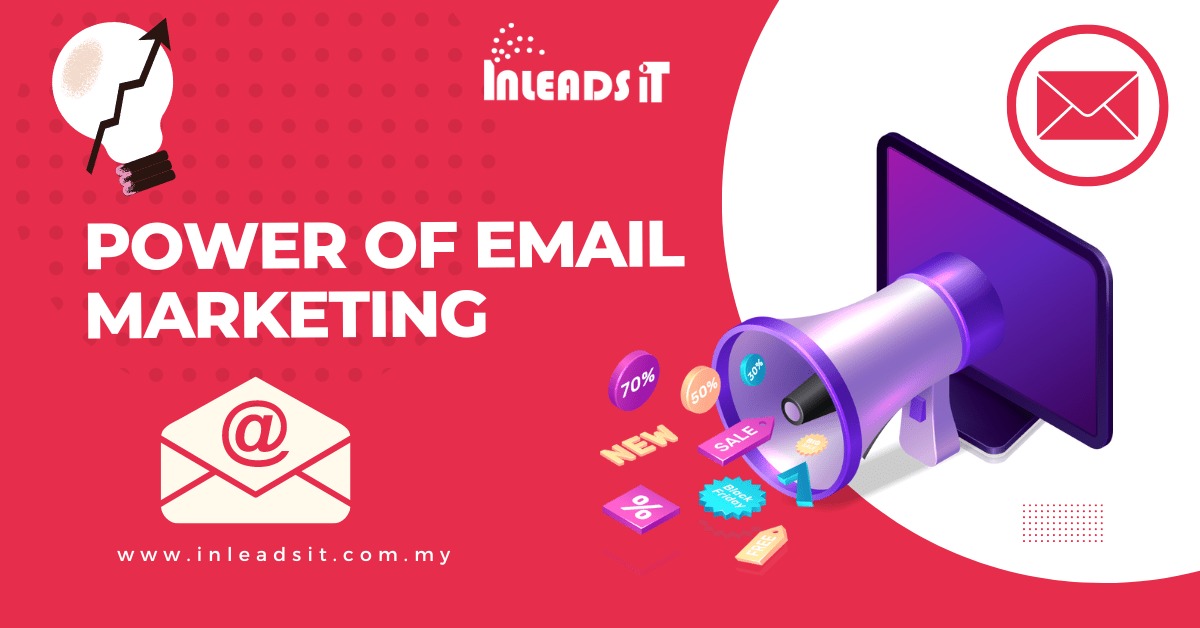
In today’s digital era, where social media platforms and search engine optimization dominate the marketing landscape, it’s easy to overlook one of the most powerful and effective tools available to small businesses: power of email marketing. While it may not be as flashy as the latest social media trend, email marketing remains a tried-and-true method for connecting with customers, building brand loyalty, and driving sales.
Definition and overview of email marketing
Email marketing is the practice of sending targeted, personalized messages to a group of individuals via email. It involves creating and nurturing a list of subscribers who have opted in to receive communication from your business. These messages can range from promotional offers and product updates to newsletters and informative content. By leveraging email marketing, small businesses can stay at the forefront of their customers’ minds, establish a direct line of communication, and foster lasting relationships.
Importance of email marketing for small businesses
When it comes to marketing strategies for small businesses, email marketing offers a unique set of advantages that can have a significant impact on the bottom line. Firstly, email marketing is incredibly cost-effective and affordable compared to traditional marketing channels. With minimal overhead costs, small businesses can reach a wide audience without breaking the bank.
Secondly, email marketing allows for precise targeting and segmentation. By understanding your audience’s preferences, interests, and purchasing behaviors, you can tailor your email campaigns to deliver relevant content directly to the right people. This level of personalization not only increases engagement but also improves the likelihood of conversions.
Furthermore, email marketing plays a crucial role in building and nurturing customer relationships. By consistently delivering valuable content and offers, you can establish trust, loyalty, and a sense of exclusivity among your subscribers. In turn, this can lead to repeat business, word-of-mouth referrals, and increased customer lifetime value.
In a competitive marketplace, where small businesses often struggle to stand out, email marketing serves as a powerful tool for enhancing brand awareness and visibility. By incorporating your brand’s unique voice, visuals, and messaging into your emails, you can reinforce your brand identity and create a memorable impression in the minds of your subscribers.
Lastly, email marketing provides valuable insights and analytics that can inform decision-making and drive business growth. By tracking metrics such as open rates, click-through rates, and conversions, you can measure the effectiveness of your email campaigns and make data-driven improvements for better results.
In the following sections of this blog post, we will delve deeper into the benefits of email marketing for small businesses and explore strategies for building effective email campaigns. We will also discuss best practices and real-world case studies that highlight the power of email marketing in driving success for small businesses. So, let’s dive in and unlock the full potential of email marketing for your small business.
Benefits of Email Marketing for Small Businesses
Cost-effectiveness and Affordability
Email marketing provides a cost-effective solution for small businesses with limited marketing budgets. Compared to traditional advertising channels, such as print or television, email marketing allows businesses to reach a large audience at a fraction of the cost. With the availability of user-friendly email marketing platforms and automation tools, the financial investment required to execute effective email campaigns remains relatively low.
Wide Reach and Audience Targeting
Email marketing enables small businesses to reach a wide audience instantly. With a well-curated email list, businesses can target specific segments of their customer base, tailoring messages to their interests and preferences. This personalized approach fosters stronger connections and improves the likelihood of conversions.
Increased Customer Engagement and Loyalty
Email campaigns provide an opportunity for businesses to engage with their customers on a regular basis. By delivering valuable content, exclusive offers, and personalized recommendations, small businesses can nurture relationships with their audience. Regular communication through email helps build trust, loyalty, and a sense of community around the brand.
Improved Brand Awareness and Visibility
Through consistent email communication, small businesses can increase brand awareness and visibility among their target market. By incorporating branding elements such as logos, colors, and a consistent tone of voice, emails serve as a constant reminder of the business and its offerings. This reinforcement helps establish a strong brand presence and fosters recognition.
Enhanced Conversion Rates and Sales
Email marketing has proven to be highly effective in driving conversions and sales for small businesses. By including compelling calls-to-action (CTAs) and personalized offers, businesses can motivate recipients to take action. Whether it’s making a purchase, signing up for a webinar, or downloading a free resource, well-crafted emails can significantly increase conversion rates and generate revenue.
Tracking and Analytics for Better Decision-Making
One of the significant advantages of email marketing is the ability to track and analyze campaign performance. Email marketing platforms provide valuable insights into metrics such as open rates, click-through rates, and conversion rates. By analyzing this data, small businesses can gain valuable insights into their audience’s preferences, optimize their email content, and make data-driven decisions to improve future campaigns.
Building an Effective Email Marketing Strategy
A. Building a quality email list:
- Opt-in forms and lead magnets:
- Implementing opt-in forms on your website or landing pages to capture email addresses.
- Offering lead magnets such as e-books, exclusive content, or discounts in exchange for email subscriptions.
- Ensuring transparency and providing clear value propositions to encourage sign-ups.
- Segmenting your email list:
- Dividing your email list into targeted segments based on demographics, interests, or past interactions.
- Tailoring your content and offers to each segment, resulting in higher engagement and conversion rates.
- Using customer relationship management (CRM) tools to efficiently manage and organize your segmented lists.
B. Crafting compelling email content:
- Writing engaging subject lines:
- Creating attention-grabbing subject lines that entice recipients to open your emails.
- Incorporating personalization, curiosity, urgency, or value propositions to increase open rates.
- A/B testing subject lines to identify the most effective ones.
- Personalization and customization:
- Addressing recipients by their names and personalizing the content based on their preferences.
- Utilizing dynamic content to tailor messages to specific segments or individual subscribers.
- Analyzing customer data to understand their interests and deliver relevant content.
- Using persuasive calls-to-action (CTAs):
- Including clear and compelling CTAs that guide recipients towards desired actions.
- Using action-oriented language and creating a sense of urgency to drive click-throughs.
- Optimizing CTAs for different devices and ensuring they are prominently displayed.
C. Designing visually appealing emails:
- Mobile-friendly design considerations:
- Designing responsive emails that adapt to different screen sizes and devices.
- Ensuring legibility by using appropriate fonts, colors, and formatting.
- Testing emails on various mobile devices to ensure optimal display.
- Effective use of visuals and branding:
- Incorporating eye-catching visuals, such as images or videos, to capture recipients’ attention.
- Consistently representing your brand through the use of logos, colors, and visual elements.
- Striking a balance between visuals and text to maintain a visually appealing layout.
D. Establishing a consistent email schedule:
- Determining optimal frequency:
- Finding the right balance between staying top-of-mind and avoiding overwhelming subscribers.
- Considering factors such as industry norms, audience preferences, and available resources.
- Tracking engagement metrics to identify the frequency that generates the best results.
- Testing and optimizing send times:
- Experimenting with different send times to determine when your audience is most likely to engage.
- Analyzing open and click-through rates based on send times and refining your schedule accordingly.
- Considering time zone variations and segmenting your audience for more targeted timing.
Tips for Successful Email Campaigns
Creating a Strong First Impression with Welcome Emails
The first impression is crucial in email marketing. Welcome emails are the perfect opportunity to make a positive impact and set the tone for your relationship with subscribers. Discuss the importance of crafting personalized and compelling welcome emails that express gratitude, provide valuable information, and encourage engagement. Emphasize the need to optimize subject lines, include clear calls-to-action, and showcase your brand’s personality.
Implementing Targeted Email Automation
Automation simplifies the process of delivering timely and relevant content to subscribers. Discuss the benefits of segmenting your email list based on demographics, behavior, or preferences. Explain how automated emails such as onboarding sequences, abandoned cart reminders, or personalized product recommendations can enhance engagement and drive conversions. Highlight the importance of selecting a reliable email marketing platform with robust automation capabilities.
A/B Testing to Refine Email Performance
A/B testing, also known as split testing, allows you to experiment with different elements of your email campaigns to determine what resonates best with your audience. Provide insights into the elements that can be tested, including subject lines, email content, visuals, CTAs, and sending times. Explain how conducting A/B tests and analyzing the results can help optimize open rates, click-through rates, and overall campaign performance.
Ensuring Email Deliverability and Avoiding Spam Filters
Email deliverability plays a crucial role in the success of your campaigns. Outline strategies to improve deliverability, such as maintaining a clean email list, using double opt-in, avoiding spam trigger words, and following email authentication protocols like SPF and DKIM. Discuss the importance of monitoring email bounces, spam complaints, and engagement metrics to maintain a healthy sender reputation.
Maintaining GDPR and CAN-SPAM Compliance
Compliance with data protection regulations is vital to safeguard your subscribers’ privacy and maintain trust. Explain the key provisions of GDPR (General Data Protection Regulation) and CAN-SPAM Act, including obtaining consent, providing unsubscribe options, and including a physical mailing address. Offer tips on how to create GDPR-compliant forms, manage subscriber preferences, and handle data securely. Stress the significance of regularly reviewing and updating your privacy policy.
Email Marketing Best Practices for Small Businesses
Personalizing Email Communication
One of the key elements of successful email marketing is personalization. By addressing subscribers by their name and tailoring the content to their preferences, you can create a more meaningful connection. Use data from your subscribers to segment your email list and send targeted emails based on demographics, purchase history, or browsing behavior. Personalized emails have higher open rates, click-through rates, and conversion rates, making them a crucial aspect of your email strategy.
Providing Valuable and Relevant Content
To engage your subscribers and keep them interested, it’s crucial to provide valuable and relevant content in your emails. Understand your audience’s pain points, interests, and preferences, and create content that addresses their needs. Offer educational resources, industry insights, exclusive discounts, or helpful tips that align with your subscribers’ interests. By delivering valuable content consistently, you build trust, establish your expertise, and increase the chances of conversion.
Engaging with Subscribers Through Interactive Elements
Make your emails interactive and engaging to capture your subscribers’ attention. Incorporate interactive elements such as polls, surveys, quizzes, or interactive images to encourage participation. Interactive content not only increases engagement but also provides valuable insights into your subscribers’ preferences and opinions. By involving your audience in the email experience, you foster a sense of connection and create a memorable brand experience.
Encouraging Social Sharing and Referrals
Leverage the power of social media by encouraging your subscribers to share your emails with their networks. Include social sharing buttons within your emails to make it easy for recipients to share interesting content or offers. Additionally, implement referral programs that incentivize your subscribers to refer friends and family to your business. Referrals can bring in new customers who are more likely to convert due to the trust and recommendation from someone they know.
Monitoring and Analyzing Email Campaign Metrics
To measure the effectiveness of your email campaigns and identify areas for improvement, it’s essential to monitor and analyze key metrics. Track metrics such as open rates, click-through rates, conversion rates, and unsubscribe rates to gauge the performance of your emails. Use email marketing analytics tools to gain insights into subscriber behavior, campaign success, and areas that need optimization. Regularly review and analyze these metrics to make data-driven decisions and refine your email strategy.
Continuously Optimizing and Improving Email Campaigns
Email marketing is an iterative process that requires continuous optimization. Test different elements of your emails, such as subject lines, CTAs, visuals, and send times, through A/B testing. Analyze the results and make data-driven improvements to optimize your campaigns. Keep up with industry trends and best practices, experiment with new strategies, and adapt your approach accordingly. By continually refining your email campaigns, you can achieve better results and drive long-term success.
Case Studies: Small Businesses That Thrived with Email Marketing
Email Marketing Strategy:
- Building a quality email list:
- How they encouraged website visitors to opt-in to their email list
- Effective use of lead magnets to attract subscribers
- Compelling email content:
- Crafting personalized and engaging subject lines
- Customizing emails based on customer preferences and purchase history
- Using persuasive CTAs to drive conversions
- Visually appealing emails:
- Design elements that reflect their brand identity
- Mobile-friendly design to cater to a growing mobile audience
Success and Results:
- Increased customer engagement and loyalty:
- Examples of open rates and click-through rates
- Testimonials from satisfied customers
- Improved sales and conversions:
- How email marketing campaigns directly contributed to revenue growth
- Conversion rates and revenue generated from email campaigns
B. Case Study 2: ABC Coffee Shop
Email Marketing Strategy:
- Building a quality email list:
- Leveraging their in-store customer database to gather email addresses
- Encouraging customers to sign up for their loyalty program
- Compelling email content:
- Offering exclusive discounts, promotions, and special events to subscribers
- Sharing engaging and relevant content, such as coffee recipes and brewing tips
- Visually appealing emails:
- Creative use of imagery to showcase their products
- Consistent branding and design across all email communications
Success and Results:
- Increased customer retention and repeat business:
- Examples of customer feedback and loyalty program participation
- Metrics showing an increase in returning customers
- Enhanced brand awareness and customer reach:
- Social media integration in emails leading to increased followers and engagement
- Growth in the number of subscribers due to word-of-mouth referrals
Conclusion
Email marketing has proven to be a powerful tool for small businesses, offering numerous benefits and opportunities for growth. In this blog post, we explored the key advantages of email marketing, such as its cost-effectiveness, wide reach, and ability to engage customers. We also discussed how email marketing can improve brand awareness, boost conversion rates, and provide valuable tracking and analytics data.
To harness the power of email marketing, it is important for small businesses to build an effective strategy. This includes building a quality email list, crafting compelling content, designing visually appealing emails, and establishing a consistent email schedule. By following these steps, businesses can maximize the impact of their email campaigns and drive results.
Additionally, we provided some essential tips and best practices for successful email marketing campaigns. Personalization, providing valuable content, engaging with subscribers, and monitoring campaign metrics are all critical components of a successful strategy. By implementing these best practices, small businesses can create meaningful connections with their audience and achieve their marketing goals.
Furthermore, we highlighted the importance of continuously optimizing and improving email campaigns. A strong first impression, targeted automation, A/B testing, and compliance with regulations are all key factors in achieving success with email marketing. It is essential to stay up-to-date with industry trends and adapt strategies accordingly.
In conclusion, the power of email marketing for small businesses cannot be underestimated. It offers an affordable and effective way to reach and engage with customers, increase brand awareness, and drive sales. By implementing or improving email marketing strategies, small businesses can unlock new opportunities for growth and success. As technology evolves and consumer behavior changes, email marketing will continue to play a crucial role in the future of small business marketing.
Don’t miss out on the potential of email marketing. Embrace this powerful tool and watch your small business thrive in the digital landscape.
FAQ
What is email marketing?
Email marketing refers to the practice of sending targeted messages or promotional content to a group of individuals via email. It is a powerful marketing tool that allows businesses to communicate with their audience, build relationships, and promote their products or services.
Why is email marketing important for small businesses?
Email marketing is particularly important for small businesses because it offers a cost-effective and efficient way to reach a wide audience. It helps in increasing customer engagement and loyalty, improving brand visibility, driving conversions and sales, and providing valuable data for decision-making.
How does email marketing benefit small businesses?
Email marketing offers several benefits for small businesses, including:
- Cost-effectiveness: It is more affordable compared to traditional marketing methods.
- Wide reach and audience targeting: It allows businesses to target specific segments of their audience with personalized messages.
- Increased customer engagement and loyalty: Regular communication through emails helps to build stronger relationships with customers.
- Improved brand awareness and visibility: Email campaigns can increase brand recognition and keep businesses top-of-mind.
- Enhanced conversion rates and sales: Emails can drive conversions by promoting products, offering discounts, or showcasing new offerings.
- Tracking and analytics: Email marketing platforms provide valuable insights into open rates, click-through rates, and customer behavior, enabling businesses to make data-driven decisions.
How can I build an effective email marketing strategy for my small business?
To build an effective email marketing strategy, consider the following steps:
- Build a quality email list: Use opt-in forms, lead magnets, and segment your list based on demographics or behavior.
- Craft compelling email content: Write engaging subject lines, personalize messages, and use persuasive calls-to-action.
- Design visually appealing emails: Ensure mobile-friendly design, use visuals that align with your brand, and maintain consistency.
- Establish a consistent email schedule: Determine the optimal frequency, test different send times, and be consistent in your communication.
What are some tips for successful email campaigns?
Here are some tips to make your email campaigns successful:
- Send welcome emails to create a strong first impression.
- Implement targeted email automation to save time and increase relevance.
- Conduct A/B testing to refine your email performance and improve results.
- Ensure email deliverability by following best practices and avoiding spam filters.
- Maintain GDPR and CAN-SPAM compliance to protect subscriber privacy.
What are some best practices for small business email marketing?
Consider the following best practices for small business email marketing:
- Personalize your emails to make them more relevant and engaging.
- Provide valuable and relevant content to your subscribers.
- Incorporate interactive elements like polls, surveys, or quizzes to boost engagement.
- Encourage social sharing and referrals by including social media buttons or referral programs.
- Monitor and analyze email campaign metrics to measure success and identify areas for improvement.
- Continuously optimize and improve your email campaigns based on data and customer feedback.
Can you provide examples of small businesses that succeeded with email marketing?
Yes, here are a few examples of small businesses that thrived with email marketing:
- XYZ Clothing Boutique: Increased online sales by 30% through targeted email campaigns promoting new arrivals and exclusive discounts.
- ABC Coffee Shop: Built a loyal customer base by sending weekly newsletters with updates, special offers, and personalized recommendations.
- QRS Fitness Studio: Increased class bookings and customer retention by sending automated birthday emails, personalized workout tips, and motivational content.








